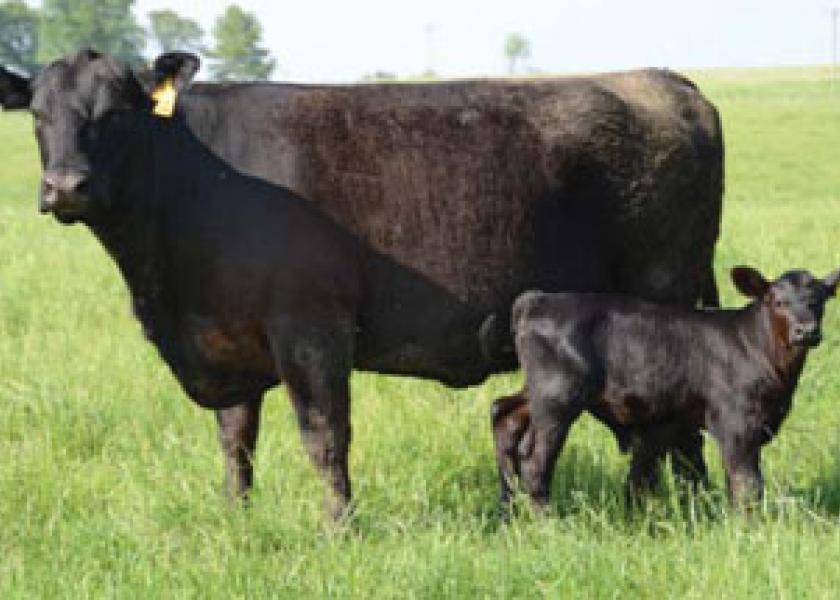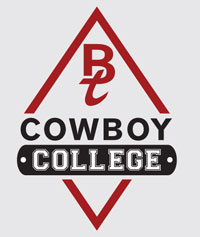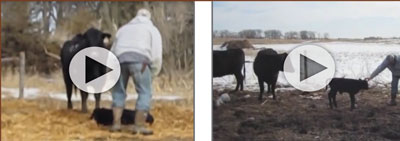A Matter of Trust

Benefits of low-stress handling start at birth
Every rancher wants productive, easy tempered cattle in the pasture and heavy weight calves at weaning. But often the behavior choices of the cattle are directly impacted by the behavior choices of the rancher.
At the recent Cow-Calf Cowboy College, Tom Noffsinger educated 120 cattlemen and women about low-stress handling techniques they could put into practice on their ranch for better production efficiencies and animal wellness. “Producers have a huge impact on whether or not calves will need antibiotics and healthcare in the feedlot. If the animal doesn’t trust us, they are not going to be honest in how they feel. They will hide lameness and early sickness,” he says.
 |
Even small steps at the very start of a calf’s life will have major implications for it’s overall health and growth. For example, Noffsinger says he used to think cows knew how to take care of their babies, but he would often see cows calving in the back of the pasture, come to the feeding area to eat all day and then go back to the calf to nurse once or twice a day. “If you have a calf that eats twice a day, he’s different than a calf that eats 20 times a day. The idea that we could change that behavior was new to me,” he says.
Producers can help encourage the maternal bonding between a cow and calf by the way they move and interact with pairs. “Do not do that in a random fashion,” Noffsinger adds. “Notice if the mother is separated by more than 10 yards, and in a gentle and calm fashion, encourage her to go back to the baby or the baby back to the mother. In this way, you are teaching those babies that when you are present they are expected to stand and to go find their mothers and nurse or the mother is to go find their baby.”
These simple actions lead to big benefits. Calves that eat small meals of carbohydrates through the day, instead of two large intakes, develop a better digestive system and an increasing appetite—a trait that often follows them into the feedlot, he adds.
Even at tagging, producers have an opportunity to create positive interactions with cows and newborn calves. Andrew Arhart, a rancher in Alpena, S.D., has seen positive impact from changing protocols at tagging.
“Instead of using a ‘grab and go’ method, now we take our time,” Arhart says. “We let the cow and calf bond and nurse for at least 12 hours before we tag it. When we approach them, we walk slowly towards them, backing up or changing our angle based on reading the cow and calf’s reaction. We draw the calf to us, comforting the cow enough that we can eventually walk up to the calf.”
Arhart and his wife, Melissa, started working with Noffsinger about seven years ago to incorporate low-stress handling techniques into their operation. Melissa later started videoing tutorials of low-stress handling methods to share with other local producers.
 |
Andrew and Melissa Arhart’s animal handling videos help illustrate proper animal handling procedures. For a link to watch the videos and to learn more from Tom Noffsinger’s presentation at the 2015 Cowboy College, visit www.BeefToday.com/animal_handling |
“The cows are so much calmer—it’s amazing when you watch the videos,” Arhart says. “The calf actually comes to you to get tagged if you do it the correct way. When the calf does that, then I’m not the aggressor or threat, so the cow doesn’t get excited. Her cortisol levels and hormones aren’t destroying the colostrum for the calf. She’s calm because the calf is having a good experience and coming over to see what this is and what I’m doing.”
Noffsinger says it’s important to watch the cow’s reaction to your presence. “Cattle hate a direct approach, so we walk across her field of vision, and if she doesn’t move, we’d walk across at an angle to get closer.
“At the same time, it is important to notice if the baby calf moves. Often, the baby is the more sensitive of the two. And then if that baby has some response to your presence, it’s important to change angles, or step back, and show that baby you respect his or her response to your stimulus. Calves really respond to that quickly. Teach that little baby to walk toward you. Once the mother senses that the calf trusts you and responds to you and takes guidance from you, she will relax.”
Arhart says he often hears producers say “these methods would never work with their cows,” but it does take a concerted effort to influence positive behavior.
“You have to consistently work with the animals. But it does work,” he says. “It might seem like it takes longer, but some of the clips are only two minutes long—so it maybe took 30 seconds extra—but look at the outcome and benefit of not have the cows excitable or the calf running off. It’s just so much easier on everybody.”
With many herds in the process of expansion, producers have a good opportunity to influence their entire production system. “In a growing cowherd, the fastest way to change behavior in a cow-calf operation is to create confidence in the replacement animals,” Noffsinger says. “It’s contagious for the rest of the herd.”
“Teach heifers to be confident in the processing ally and chute, to pass by a handler and to be able to sort them in a 14' alley. All of this contributes to levels of animal well-being, health and performance for their lifetime,” he says.
The Arharts, who ranch and farm with Andrew’s brother, Jonathan, and his wife, Joy, found they could increase their herd size with the same level of management.
“We thought we’d need employees if we ever expanded,” Andrew says. “Until two years ago, we ran 250 cows, and we were always afraid of doubling the herd because we didn’t think we had the labor. We found out, using low-stress methods, we didn’t need a lot of extra labor—we just worked smarter.”
All of these details lead to better performance and healthier animals, Noffsinger adds.
“Any time we are moving cattle, weaning, tagging—these are training opportunities,” he says. “Cows should not go through a gate without their baby beside them. You’ll start noticing that not only do they travel together, but the herd starts to graze as an unit—where the mother goes, the baby is nearby ready to eat and grow.”
Arhart adds this is one reason being a cattleman is so important to him. “When you walk away from tagging a calf and they follow you instead of going to their mom, that’s pretty cool,” Arhart says. “It shows they had a good experience with you.”
Tips to Easier Tagging
- Approach the calf using proper handling procedures. Let the calf come to you—the mother will be less stressed and protective.
- Catch the calf and stroke its back until it is calm before tagging.
- After tagging, control the calf’s departure so that mother and baby reconnect before leaving you.
- Each cow-calf pair should have a training and handling lesson: move the mom and baby, stop and put them together again. This helps them learn that they should always go together.







